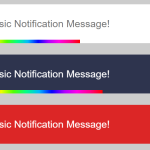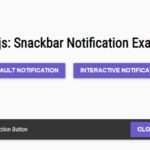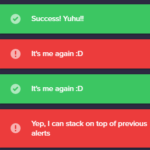| Author: | codeawapps |
|---|---|
| Views Total: | 0 views |
| Official Page: | Go to website |
| Last Update: | January 20, 2025 |
| License: | MIT |
Preview:

Description:
yetialerts is a lightweight JavaScript library to display customizable toast- and growl-style alert notifications on your web app where you need to communicate with users through status messages, alerts, and notifications.
This library provides smooth fade/slide animations, stackable alerts, pre-built themes and supports multiple notification types for different scenarios – success, warnings, error, and information.
How to use it:
1. Download and load the yetialerts’ JavaScript and CSS files in the document.
<link rel="stylesheet" href="/yeti-alerts.css" /> <script src="/yeti-alerts.js"></script>
2. Initialize YetiAlerts and display your first alert notification:
const yeti = new Yeti();
yeti.show({
message: 'This is a default alert!'
});3. Set different notification types using the severity option: ‘ok’, ‘nok’, ‘warn’, and ‘info’
yeti.show({
message: 'This is a warning alert!',
severity: 'warn'
});4. By default, the alerts fade when the next alert appears. You can disable that by adding the fadeOnNext: false option.
yeti.show({
message: 'This is a warning alert!',
fadeOnNext: false
});5. By default, alerts persist until you close them or another alert appears (unless fadeOnNext: false is set). You can set a duration for the alert to automatically disappear using the time option (in milliseconds). Setting a time value makes the alert non-closable.
yeti.show({
message: 'This is a warning alert!',
time: 5000
});6. You can further customize alerts with these options:
yeti.show({
title: '',
width: 50,
shadow: true,
border: 0,
});7. You can modify the look of the alerts using CSS variables. Override these variables in your stylesheet’s :root or a specific CSS rule:
:root {
--yeti-bg-ok: #ebffec;
--yeti-ok: #31a335;
--yeti-bg-nok: #fdf2f1;
--yeti-nok: #f44336;
--yeti-bg-warn: #fff8ec;
--yeti-warn: #ed7a00;
--yeti-bg-info: #e6f4ff;
--yeti-info: #0083ee;
--yeti-close: #777;
--yeti-shadow: #00000025;
--yeti-radius: 5px;
--yeti-gap: 10px;
--yeti-font: 1em;
}









